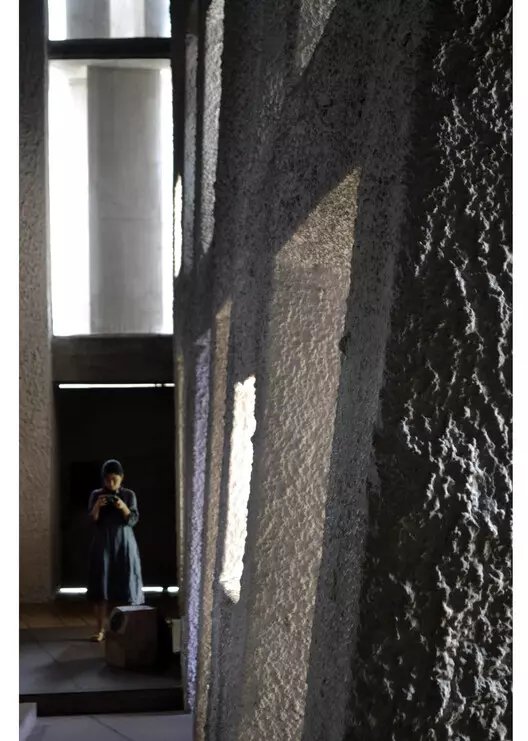 Capilla Notre Dame du Haut / Le Corbusier - 1955. Image © Mili Sánchez Azcona
Capilla Notre Dame du Haut / Le Corbusier - 1955. Image © Mili Sánchez Azcona
What makes architecture truly exceptional? If we were to ask Vitruvius, the renowned Roman architect from over two thousand years ago, he would emphasize the importance of firmness, utility, and beauty. However, in today's world, the definition of good architecture has evolved into something more subjective and personal, focusing on the individual experience.
One perspective that holds significance is architecture's ability to evoke emotions and create unforgettable moments. It is about designing spaces that transcend mere functionality and become poetic, ineffable realms that defy description. Le Corbusier's Notre Dame du Haut Chapel in Ronchamp, France, epitomizes this concept by offering a unique and timeless experience.
A Departure from Conventional Approaches
 Capilla Notre Dame du Haut / Le Corbusier - 1955. Image © Mili Sánchez Azcona
Capilla Notre Dame du Haut / Le Corbusier - 1955. Image © Mili Sánchez Azcona
Le Corbusier's journey toward the creation of this masterpiece took him away from his earlier rationalist and mechanistic approach. With the Notre Dame du Haut Chapel, he embraced a unique formal exploration, abandoning universal principles in favor of a deeply personal response. The result was an enigmatic work of art that defies categorization and stands the test of time.
Unveiling the Mystery
There is an intriguing anecdote from the 1950s about two architects visiting Le Corbusier's office in Paris. As they waited in a former Jesuit monastery, immersed in the atmosphere of daily work, Le Corbusier made a profound statement: "Do you know why God is so important? Because you can't see him." This cryptic remark sheds light on Le Corbusier's introspective and possibly agnostic nature, leaving us with more questions than answers. Despite not adhering to any particular religion, he acknowledged the significance of the inexplicable and the miracles found in ineffable spaces.
 Capilla Notre Dame du Haut / Le Corbusier - 1955. Image © Mili Sánchez Azcona
Capilla Notre Dame du Haut / Le Corbusier - 1955. Image © Mili Sánchez Azcona
The Essence of Ineffable Space
Despite its enigmatic nature, the Notre Dame du Haut Chapel invites us to experience the sacred without relying on words. It offers a sublime and emotional encounter that surpasses verbal explanation. Le Corbusier's ability to create such spaces showcases his belief in the power of architecture as a complete work of art.
The Photo Essay: Capturing the Ineffable
 Capilla Notre Dame du Haut / Le Corbusier - 1955. Image © Mili Sánchez Azcona
Capilla Notre Dame du Haut / Le Corbusier - 1955. Image © Mili Sánchez Azcona
To provide a glimpse into this awe-inspiring work, we present a photo essay that attempts to capture the essence of the ineffable. These images allow us to embark on a visual journey through one of the most captivating architectural accomplishments of the 20th century.
 Capilla Notre Dame du Haut / Le Corbusier - 1955. Image © Mili Sánchez Azcona
Capilla Notre Dame du Haut / Le Corbusier - 1955. Image © Mili Sánchez Azcona
 Capilla Notre Dame du Haut / Le Corbusier - 1955. Image © Mili Sánchez Azcona
Capilla Notre Dame du Haut / Le Corbusier - 1955. Image © Mili Sánchez Azcona
 Capilla Notre Dame du Haut / Le Corbusier - 1955. Image © Mili Sánchez Azcona
Capilla Notre Dame du Haut / Le Corbusier - 1955. Image © Mili Sánchez Azcona
 Capilla Notre Dame du Haut / Le Corbusier - 1955. Image © Mili Sánchez Azcona
Capilla Notre Dame du Haut / Le Corbusier - 1955. Image © Mili Sánchez Azcona
 Capilla Notre Dame du Haut / Le Corbusier - 1955. Image © Mili Sánchez Azcona
Capilla Notre Dame du Haut / Le Corbusier - 1955. Image © Mili Sánchez Azcona
 Capilla Notre Dame du Haut / Le Corbusier - 1955. Image © Mili Sánchez Azcona
Capilla Notre Dame du Haut / Le Corbusier - 1955. Image © Mili Sánchez Azcona
 Capilla Notre Dame du Haut / Le Corbusier - 1955. Image © Mili Sánchez Azcona
Capilla Notre Dame du Haut / Le Corbusier - 1955. Image © Mili Sánchez Azcona
 Capilla Notre Dame du Haut / Le Corbusier - 1955. Image © Mili Sánchez Azcona
Capilla Notre Dame du Haut / Le Corbusier - 1955. Image © Mili Sánchez Azcona
Conclusion
The Notre Dame du Haut Chapel is a testament to the profound impact architecture can have on our emotions and spirituality. Through Le Corbusier's remarkable vision, this project transcends conventional boundaries and becomes a gateway to the sacred. Visiting this architectural marvel allows us to embrace the ineffable and immerse ourselves in an experience that words simply cannot capture.
Editor's Note: This article was originally published on September 27, 2022.

















